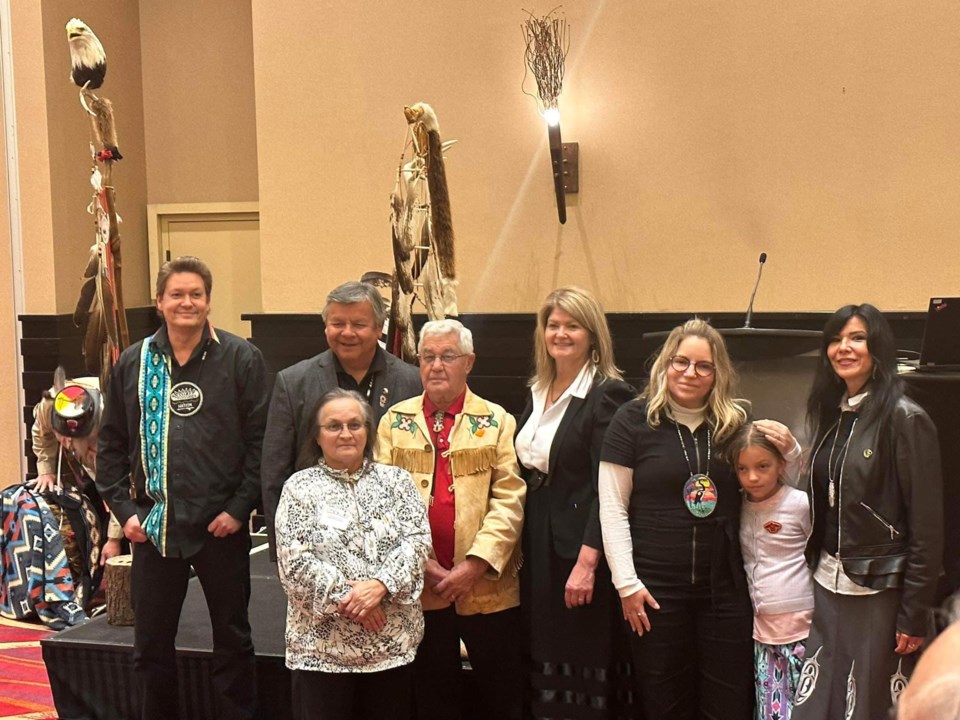In late autumn, exactly 100 years after their kin had signed the 1923 Williams Treaties, descendants of those signatories representing seven Anishinaabeg Nation communities in Ontario gathered at Rama to observe the centennial of that accord.
In 1923, the Anishinaabeg would not have been able to gather as readily as they could today. The only people who could travel by car at that time were the commissioners representing Canada and Ontario. Thus, the commission visited all of them separately through 1922 and 1923.
The Williams Treaty was named for the chair of the government-sanctioned commission, Angus Seymour Williams. Williams was entrusted to persuade the leadership of the seven communities to share interest in 300 square kilometres of Ontario and that, in exchange, their interests in their traditional hunting territories would be protected forever.
Up to that point in history, the Anishinaabeg in this region had been petitioning the Canadian government against the incursion of settlers into their hunting grounds. They wished to be free to harvest without the threat of violence just as they had for countless millennia. They desired a time when they would no longer have to endure the density of encroachment upon their traditional hunting grounds.
Williams fulfilled his mandate set out by his masters as commission chair and convinced the leadership of all seven communities that it was the intent of Canada and the Province of Ontario to assist the First Nation communities of Alderville, Beausoleil (Christian Island), Curve Lake, Georgina Island, Rama, Scugog and Hiawatha from further encroachment and to declare protection of their rights to harvest on the land.
The descendants of the signatories from those seven First Nation communities who assembled at Rama in late autumn understood that those promises by Williams were never delivered within those first 100 years. As a result, their people had endured the hardship of the broken promises and the hollow words of Williams for an entire century.
So, on this late autumn day, the mood of those who assembled in Rama to observe and re-examine that 100-year journey was jovial and hopeful as delegates from the Williams Treaties flowed into the halls of Casino Rama Resort. They gathered to retrace for one another the pathways of resiliency that led them to this day.
Of the delegates, speaker upon speaker articulated, in Anishinaabemowin and in English, the immense pride they held within themselves and for everyone as far back as their great-grandparents having the ability to survive the mountainous adversity visited upon them under the suffocating, demoralizing, and trying policies of Canada and the Province of Ontario. They spoke of how governments — federal, provincial and municipal — had tried to extinguish their traditional way of life, even though they had signed treaties that stated otherwise. They expressed how, over time, they had been forced out of their family hunting grounds and were made to abandon their traditional harvesting lest they be criminally charged and incarcerated by overzealous authorities.
There was much adversity to overcome along this pathway of resilience. The challenges were immediate.
Each of the delegates who spoke here at Rama relayed to the audience what had sustained the people along the way. Their resilience was bundled in their ancestral knowledge and teachings. What had survived, what had been passed onto them, was their connection to the land — the understanding that they were a part of the land in more ways than just the idea of having lived on it for thousands of years. It was deeper than that. Theirs is a spiritual connection. And even through denial of their rights by government and the challenges of Supreme Court rulings against their right to harvest on the land they grew up knowing as being a part of their very being, they persevered.
Finally, in late autumn of 2018, they received an apology from both Canada and the Province of Ontario for the negative impacts that the Williams Treaties had placed upon each of the seven First Nations. Plus, they received a recognition of pre-existing rights to harvest under pre-Confederation treaties covering much of the same territory.
This gives the Williams Treaty First Nations a chance to live out what had been promised to them and taken away by a not-so-benevolent official 100 years ago. His name will live on in this treaty. Hopefully, his legacy of deceit will not. However, even at this writing, Williams Treaty First Nation members find themselves being intimidated and harassed within their harvesting grounds by officials representing Canada and the province, even after that official apology in 2018, even after the Williams Treaty First Nations have ensured their harvesters are following sound conservation practices.
Questions continue to be left hanging in the wind along with the wishes of the old ones who came before us. Are the Williams Treaty First Nations to endure another 100 years of deceit? Or can we do the right thing and clean the corroded edges of the nameplate of the treaty’s namesake, Angus Seymour Williams?
After all, by definition, treaties are supposed to be an act of reconciliation.
Jeff Monague is a former chief of the Beausoleil First Nation on Christian Island, former treaty research director with the Anishnabek (Union of Ontario Indians), and veteran of the Canadian Forces. Monague, who taught the Ojibwe language with the Simcoe County District School Board and Georgian College, is currently the manager of Springwater Provincial Park. His column appears regularly.
